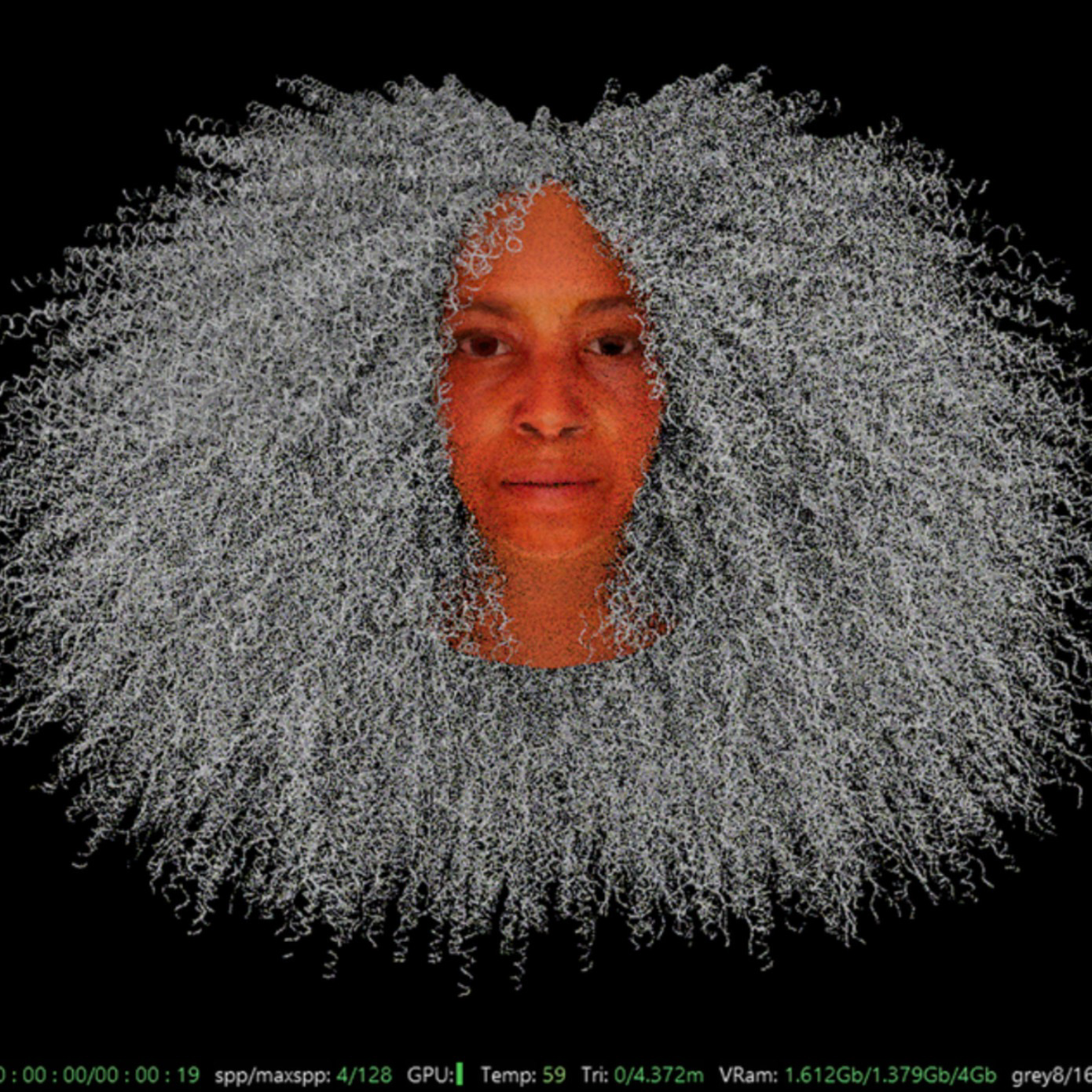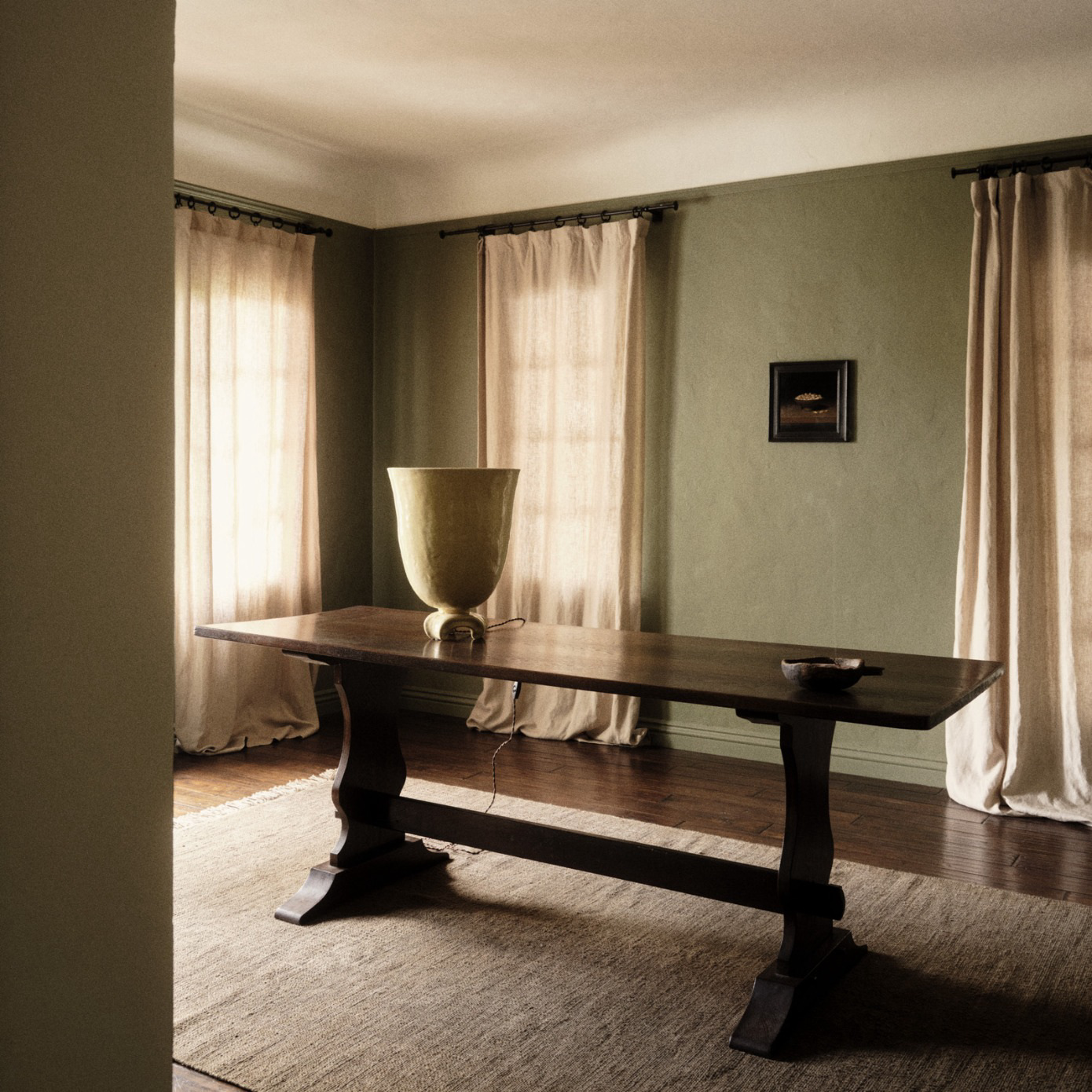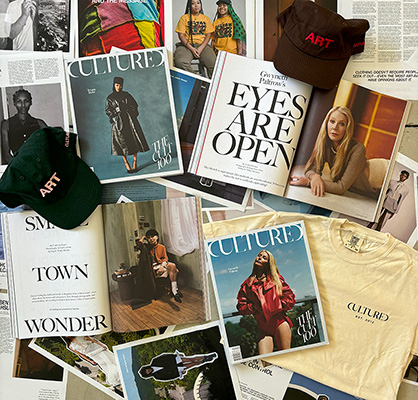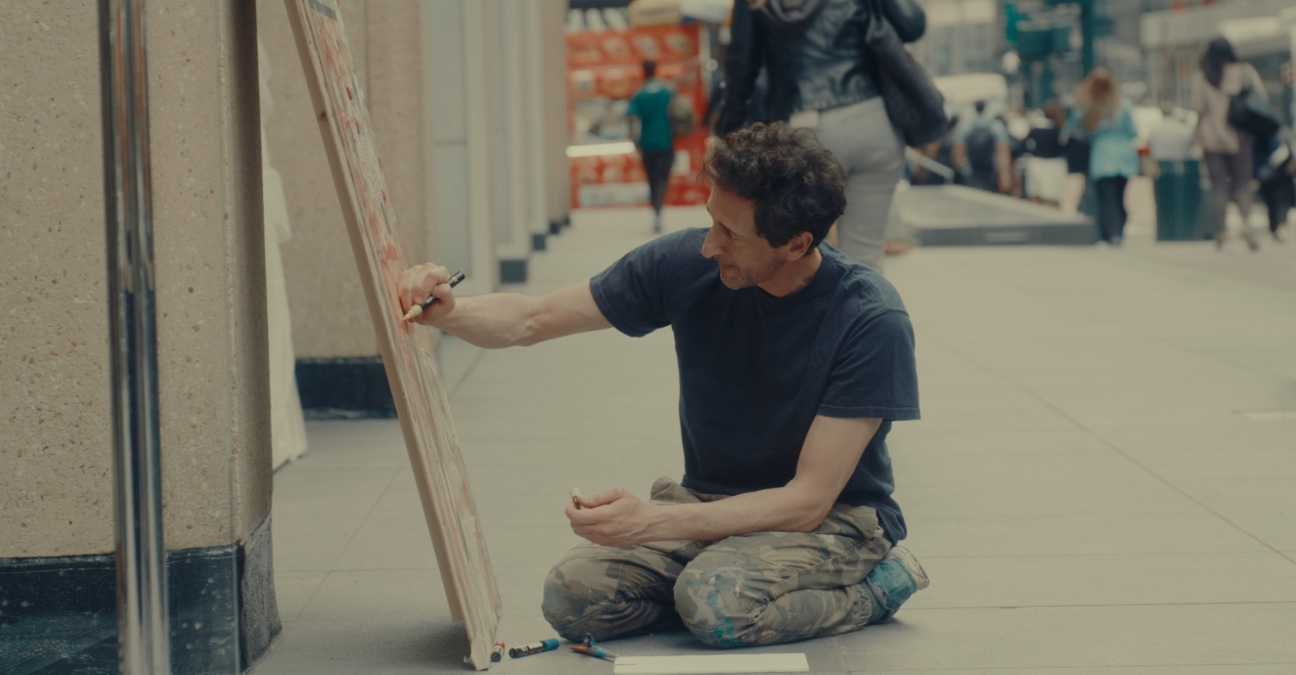
Yes, that Adrien Brody. And yes, he’s earnest about this.
The two-time Academy Award winner has opened “Made in America,” a solo show running through June 28 at Eden on Madison Avenue. It's a sometimes-perplexing, always sentimental ode to the New York of Brody's youth—part collage, part catharsis, and wholly committed. The presentation features a gum wall installation, a “Vermin” painting series, and some surprisingly dark musical beats composed by the artist. There are nods to fast food, childhood gun violence, and industrial decay, rendered with layers of paint smears, spliced cardboard sheets, and surfaces that intentionally disrupt their own polish.
“Adrien’s pictures are like time-and-space machine glimpses of the walls of the former art gallery—papered, painted, tagged, and slashed—that was once the streets of SoHo when SoHo was still SoHo…” director Wes Anderson, the actor’s close friend, shared during a gallery tour.
Known for disappearing into his characters, Brody distills the same head-tilting intensity into his artist persona. The result is messy, intimate, and almost defiantly disagreeable—perhaps that's exactly the point.

CULTURED: Can you speak to the inspiration for the works in this show?
Adrien Brody: There’s obviously a consistent theme of violent imagery. You can also see a degree of nostalgia, of my youth, and a perspective that’s both emotional and analytical. I’m checking my impulses and reactivity, which is a byproduct of growing up in New York. Themes of fast food, and things that we blindly consume in mass amounts.
CULTURED: Does the volume of references explain the varied colors, movements, and styles across the portfolio?
Brody: Growing up in the city sometimes felt overwhelming or maddening, but that frenetic energy fed who I am, and how I can play most characters, because I’ve encountered most characters. What I’ve discovered in my yearnings to paint, and in making music, is that it's a very similar collage of sight and sound. It's also akin to the way I work as an actor—distilling the nuances of human behavior and then incorporating them into a personality.
CULTURED: What themes came up for you in developing this exhibition?
Brody: It’s a mix. The guns come from this idea of, “let’s give kids M16 toys and encourage them to impress their dad,” and then we wonder why kids want to play with guns. Another theme explores what’s swept away—immigrants that are not treated with the right level of care or thoughtfulness, the homeless, the elderly, anybody.
I grew up in New York, where rats and mice were everywhere, and it's symbolic to me for many reasons. I always felt for the rats and the mice that I would see in the subways on the way to school—how everybody would be disgusted. It felt like a systematic implementation of ways to eradicate. So, I put that character in the forefront of these works, in defiance of that.

CULTURED: Your old studio was down the street from Jean-Michel Basquiat’s, who you’ve described as an influence. Which other artists do you look up to?
Brody: I'm inspired by a lot of them. I can't paint as well, but I love Hieronymus Bosch. I’m mesmerized by him. I love Van Gogh. Basquiat’s graffiti culture is something I grew up surrounded with, and he was there at the beginning of graffiti culture. I was raised in the birth of that, and the birth of hip hop, and the shift of industrialized New York toward what it has become, the elusiveness of the American Dream…
CULTURED: Do you believe in the American Dream?
Brody: I do. I’m in somewhat of a unique position, where I've grown up the son of an immigrant, an artist, and a public school teacher in Queens. I’ve managed to have a wonderful career and receive a lot of love and appreciation. I think that is symbolic of the American dream in many ways, right? But I'm also very conscious of hardships and reality, as opposed to the myth of what's attainable.
Someone just wrote something about the work having this “pop” and lightness. But that's kind of what I'm playing on. There are light references, but the deep and heavy part is also something I’m very conscious of. I grew up with my parents having to take me to the hospital all the time, blowing my hands up, buying fireworks. It’s all part of what’s available to us.
CULTURED: What do people misunderstand about your work?
Brody: Look, I don't feel the need to correct someone's perception, but that superficial glance is part of the commentary in the work, okay? And so if they miss it, they miss it, but they've also missed the work. They reference things that aren't true to what it is, and that's fine.
I know I'm in territory where it's hard to not see me in a certain way. I'm an actor by profession, but people don’t know that painting and drawing preceded that, or that I’ve been making beats for decades now. When someone hears it and they have one perception, it's incongruous, and I understand that.
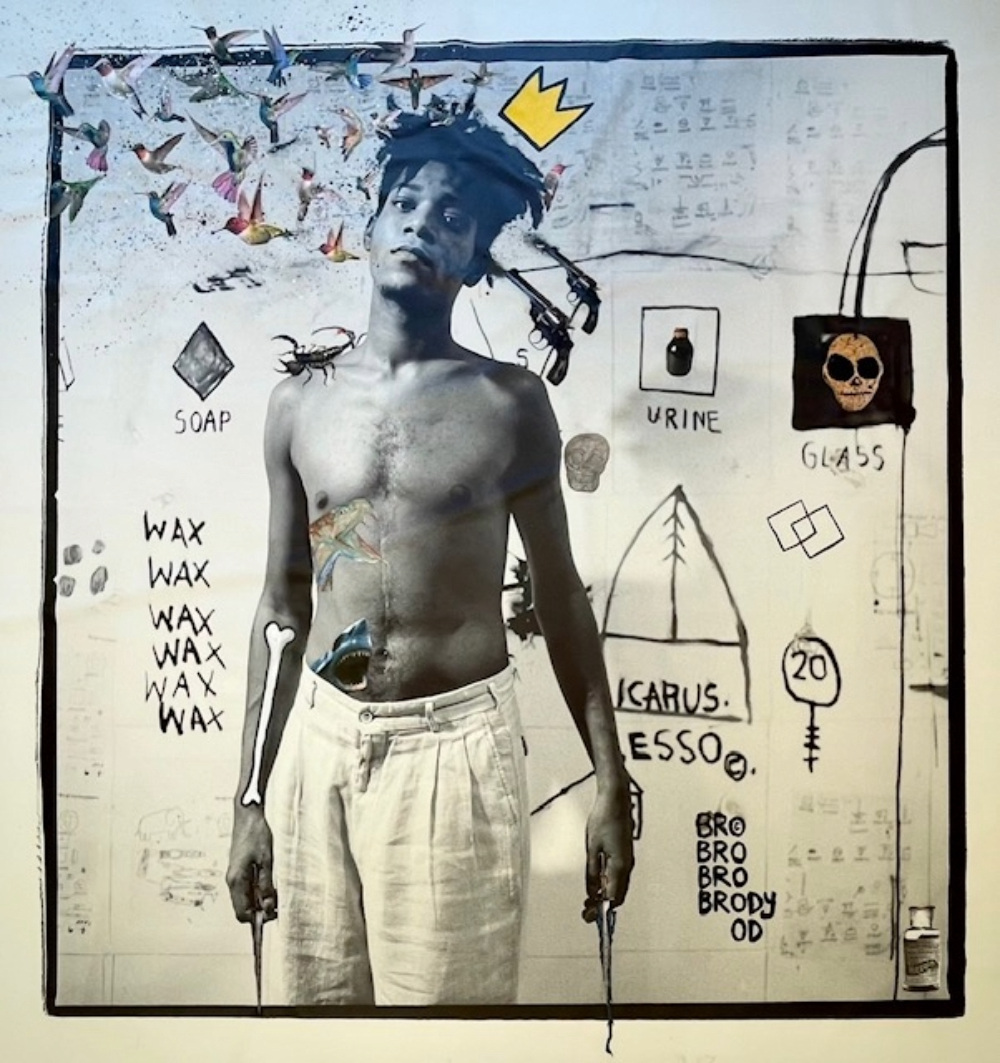
CULTURED: The pieces are quite referential to pop culture and logos. With a blank slate and your mind as sole inspiration, what would spring onto the canvas?
Brody: I've developed this way of working which is very textured, layered, and decayed, inspired by growing up in Lower Manhattan and finding great beauty. What I would do is mess the work up. I have various techniques for that. When I get it to being what I feel is already a cool piece, then I would weave in things that speak to me and that moment. Sometimes, I'll have a conceptual idea—I do dove bikes and cars—and I grew up drag racing in Queens.
CULTURED: What does your studio or network of maker spaces look like?
Brody: I have a few places. I designed a big ClearSpan building to do big works and sculptures, which I have ideas for. I've kept a place on the West Coast for a long time. I've had studios in the south of France with friends that I've shared. When I’m on location, I’ve done a bunch of paperworks and collage that were really a breakthrough for me, especially on lockdown in London during Covid.
CULTURED: Do you think your roles affect the style of art you produce?
Brody: Yes, considering everything in The Brutalist made the "Vermin" series more of a series, as opposed to me musing about it and over-contemplating. There are also films I’ve ingested, wonderful films that I grew up on in the '70s and '80s. Action tropes feed into it—early Scorsese movies, and obviously The Godfather is an influence.
CULTURED: I’m very curious about the gum wall in the gallery.
Brody: It's funny. Jackie Chan, who’s a friend of mine, came to the opening, and stuck a heart-shaped piece of gum on here, and someone stole it.

CULTURED: No! Can you share how the idea for it came about?
Brody: Well, it’s pretty self-explanatory and I have a sense of humor. Not everybody else does, you know. What I would like to do is have this travel. You know, there are gum walls in existence that are crazy! It would be amazing to see this live through a year or two of traveling shows, and then I'd like it to put it on a wall in my studio.
CULTURED: Walking around this space—what feelings come up for you?
Brody: You know, I'm living in a really grateful moment. This art is not something new that I’m trying all of a sudden, or just doing for the wrong reasons. It's taken me a long time to have the courage to share works, and I've had a lot of conversations at home with my partner (who wants it all out in my studio, because I’m always there). There’s so much that I haven’t been sharing yet.
Similarly, with my music, I have a lot of work to be done. I created a whole hour-and-a-half soundscape for the opening, an audio version of these painted works with my beats. I shared it—not to show off that I can make beats—but to show that there’s a thematic creative style in which I identify in all the work that has been important to me.
CULTURED: The music you created for the show’s opening combined reggae, R&B, and dark hip hop. Can you tell us about that?
Brody: I wanted it to be more atmospheric and not too redundant, a loop of a song structure without the verse book. This is in your ear: street noise, kids playing the playgrounds, old advertising slogans, everything. It’s all baked into the work, including a much bleaker section, because I also make really dark hip hop beats.
CULTURED: You have your own message to share.
Brody: Exactly. I’m just going to keep being creative. I feel very blessed.


